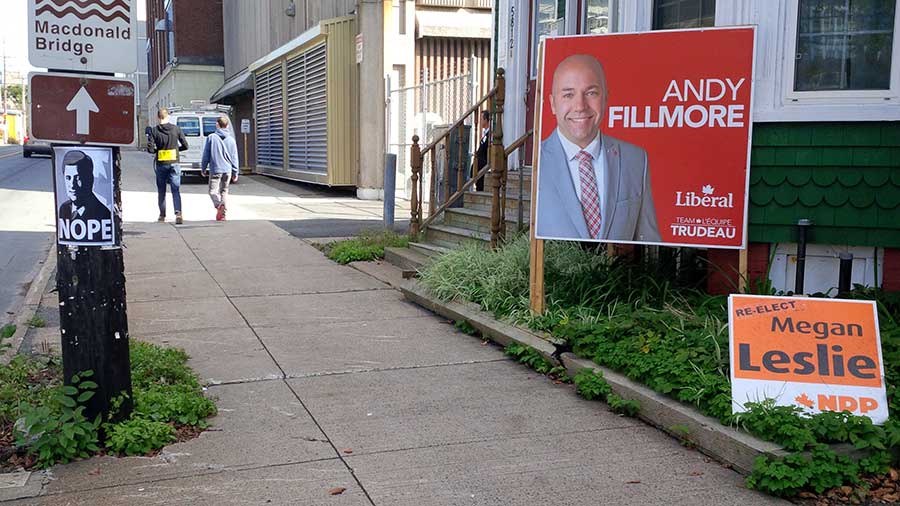Greens and NDP offer glimpse of campaign costs

The 2015 Canadian federal election campaign has been dominated by a drive to unseat Prime Minister Stephen Harper, depicted, left, in an anti-Harper poster opposite Liberal and NDP signs in Halifax, Nova Scotia. Creative Commons Attribution-ShareAlike 4.0 International Licence
Candidates for Canada’s parliament have revealed campaign expenses to Tomorrow as part of our #OpenTomorrow transparency campaign.
With the national vote set for October 19, we went to the offices of Halifax candidates Andy Fillmore for the Liberal Party of Canada, Irvine Carvery of the Conservative Party of Canada (CPC) and Megan Leslie of the New Democratic Party (NDP). We also contacted Dr Thomas Trappenberg representing the Green Party of Canada and Allan Bezanson of the Marxist-Leninist Party of Canada by email.1
We invited each campaign to offer any one election receipt for examination and publication by Tomorrow.
Dr Trappenberg offered three receipts, all printing costs, from his fight to represent the Halifax constituency totalling $688.08.
The campaign of incumbent Megan Leslie, deputy leader of the NDP,2 did not offer a receipt at the time of the visit but replied a few days later with one for printing costs, at $172.50. Her total spending as a member of parliament is detailed on a government site, but not to a receipt level.3
Mr Bezanson said he had no election expenses at all.
“Believe it or not I submit a nil expense report,” he emailed. “As a candidate I spend nothing. My Party incurs some expenses and whatever money I raise in amounts under $20 I submit to the national party organization.”
A party worker at Mr Fillmore’s office, when asked, said, “I don’t know” and made a note of the media request. Tomorrow has heard no further.
The lights were on in Mr Carvery’s office but there was nobody present. Tomorrow reached out later by email to offer him the same opportunity at transparency.
As part of the rules on campaign spending, the taxpayer provides a post-election rebate of 50 per cent to political parties, meaning Canadians are on the hook for half of what candidates use to win votes, regardless of whether they ultimately win.4
Dr Trappenberg, a professor of computer science at Dalhousie University,5 said transparency was important and often overlooked, and that he was happy to show all his campaign expenses.
He told Tomorrow by email: “I thought it quite ironic that [Prime Minister Stephen] Harper was campaigning on transparency and he is the worst offender.
“Our leader Elizabeth May has been exemplary on transparency and we have consistently called for transparency.
“In our platform we clearly state:
‘Green MPs will publish their expenses online, to ensure maximum transparency and accountability, and never use Parliamentary resources for party or personal benefit.’”
He added: “I think transparency must even go much further. If something is done in secret, there must be something wrong.
“I sit on several committees which often go ‘in-camera’. This should only be used when talking about personal cases (e.g. when talking about individual student cases as I am working at a university). Instead it is often used to keep something secret such as strategy. I don’t need a secret strategy and can say openly what I do.”

Campaign office in Halifax of Megan Leslie. Creative Commons Attribution-ShareAlike 4.0 International Licence
Christine Ackermann, running communications for the local NDP campaign, said in an email statement: “Megan Leslie has always been a transparent and accountable Member of Parliament. Her expenses have been published on her website for years. When the election campaign began, we provided a link to her MP site through the campaign website menu. It is http://meganleslieparl.ndp.ca/ on which you will find her expenses posted under the Transparent and Accountable button.”
The expenses incurred by elected – or appointed – politicians has been subject of controversy in Canada, the UK, the US and around the world. But campaign spending has been more typically reduced to reports on the costs totalling tens of millions by parties on a national or regional level with little detail. There are court cases involving election spending dating to the last Canadian federal election in 2011.
According to Elections Canada, a spending limit per party with a full slate of candidates has risen from $49,270,292 to $128,087,430 – this is calculated by party and by candidate and massively increased because of the length of the campaign. Third party advertising has ballooned from $150,000 per group to $439,411. The individual candidate spending limit in Halifax is $204,329.68.6. The national spending limit of the five parties running in Halifax are:7
- CPC: $54,936,320.15
- Green: $54,893,641.14
- Liberal: $54,936,320.15
- Marxist-Leninist: $11,912,050.15
- NDP: $54,936,320.15
Are you a candidate or third party and want to show us campaign receipts? Get in touch.
This work is licensed under the Creative Commons Attribution-ShareAlike 4.0 International Licence.
CORE PRINCIPLES APPLIED
No relevant issues on principles 1, 2, 3, 4, 5, 7, 8, 9 or 10.
6. A duty to openness: All receipts were requested to meet Tomorrow’s duty to champion openness. At the request of the Megan Leslie campaign, because the submitted invoice is from a private and not business address, we have blacked this out. The email address on the invoice is available on the touchbaseonline.ca website and therefore considered public.
11. Promote responsible debate and mediation: How should election finance be governed? How much transparency should there be and what limits would you apply?
- Formal Elections Canada list of candidates in the riding of Halifax. ↩
- Campaign website for Megan Leslie. ↩
- Canadian parliament MP expenses for Megan Leslie. ↩
- Elections Canada’s website details spending rules from 2011. The 50 per cent rebate is still valid. ↩
- Candidate profile from the Green Party. ↩
- Elections Canada details of constituency spending limits. ↩
- National limits set by Elections Canada are based on the number of candidates, hence CPC, Liberal and NDP having equal limits. ↩

